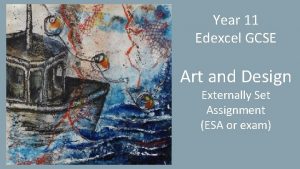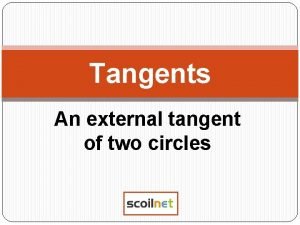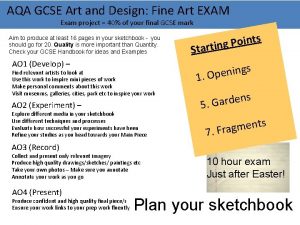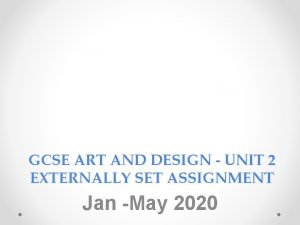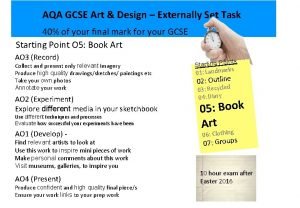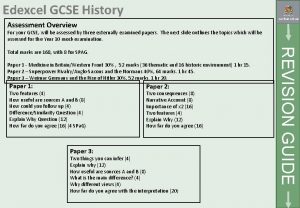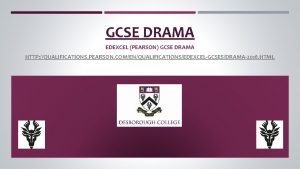Year 11 Edexcel GCSE Art and Design Externally







- Slides: 7

Year 11 Edexcel GCSE Art and Design Externally Set Assignment (ESA or exam)

Questions you might be asking yourself… ● When does the coursework element of my Art GCSE finish? ● What do I need to hand in? ● When will the work be marked? ● When will I get my marks? ● When will I get my exam paper? On the following slides. . . ● What will it look like? ● What will I be expected to prepare for my exam? ● How much time will I get to do this?

What will my exam paper look like? Your exam paper will have a theme set by Edexcel. This is the 2016 exam: Past, Present and/or Future. What will I be expected to prepare for my exam? How much time will I get to do this? You will be given a new A 3 sketchbook to develop your response to theme set by the exam board. Your supporting studies will need to show primary and secondary observational work, visual research of other artists, craftspeople and designers and development, refinement and recording of your ideas towards a final outcome. You will have approximately 14 weeks to complete this work. The Exam is equivalent 40% of your final GCSE mark. Your Sketchbook is 75% of your ESA! Your final exam will be 10 hours (over two days) and will take place in the art studios. You MUST bring your prep book to the exam on the first day and leave it there. You will not be able to do any more work to the prep once the exam has started.

What support will I get from the Art Department? Revision sessions available in school: Art Studios are open for students to work in regularly during the week: 3: 05 - 4: 30 pm. A member of art staff will be available to support students. What should students be doing at home? Students have a clear preparation and homework schedule that they need to stick to if they wish to do well in the exam. These are stuck in the front of their exam A 3 sketchbooks. Good resources to buy / access at home including websites: Essential equipment: 2 B/4 B pencils, access to camera (either digital or phone camera). Other useful equipment some paints (preferably acrylic or watercolours), charcoal pencil, good quality colouring pencils. Useful websites are listed in the exam paper.

Exemplar Materials The difference between a grade 5 and a grade 7/8/9 will depend on the quality and standard of drawing techniques, how well the student is able to experiment with a wide variety of media and materials and how they develop and realise their final ideas. The presentation or journey of ideas in their sketchbook is also very important, as well as how well they have been able to describe their work in relation to other artists and their evaluations. Examples will be shown to students in lesson and shared on Google Drive.

Art and Design GCSE: Assessment Objectives AO 1 Developing Ideas and Researching Artists Top tip for achieving a high mark for this objective. . . Make your work tell a visual story and allow your ideas, drawings and practical work to fully explain to the moderator about your journey through your project. Your annotations and written comments should support your practical work – not be used to fill gaps on the page or make up for underdeveloped practical work! AO 2 Experimenting and Selecting Media, Materials, Techniques and Processes Top tip for achieving a high mark for this objective. . . make sure that you keep ALL of your experiments, even if something doesn’t go to plan still keep it. As long as you discuss why it didn’t work and what you have learnt from the process, this will show that you understand the limitations of the materials. AO 3 Record visual ideas, annotations (writing) and observations showing a journey of ideas Top tip for achieving a high mark for this objective. . . think carefully about how you communicate your visual work – if drawing with a pencil isn’t your strongest skill, try using more expressive materials like oil pastels. Remember that this section also assesses how well you annotate. AO 4 Final Piece and how it links to your Sketchbook Top tip for achieving a high mark for this objective. . . think carefully about how you will make your work, you are marked on the quality of your final piece as well as how well your final piece/s show links with your research and development work – Have a design in sketchbook and annotate to show you will go about making it in the exam. Also say how it shows influences from your research, the artists you’ve looked at and how it’s developed from previous compositions. Explain the meaning behind your imagery (what does it show or mean).

What can I do to support my child at home? Regularly ask them to show you their prep work in their sketchbooks! Questions you can ask your child about their work: • • • How are you going to start? What do you think about the art works by the suggested artists? How do their ideas relate to the materials and techniques they have used? Is there a way you could combine the ideas and techniques of two suggested artists? How are you going to evidence observation? Are there objects and images that you could collect that are related to the starting point? How are you going to present these in your sketchbook? If you are not sure what to do how can you experiment with materials to work it out? How can this starting point become personal to you? What materials are you going to use? Have you tested that out? How do you know that will work? • How can you make your sketchbook like it is bursting with ideas?
